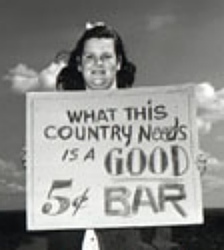As
chocolate bar sales dropped 80% overnight, a cross country protest was
set for May 3rd. But it was instantly quelled when an anonymous
person
leaked a story to the Toronto Telegram. One of the supporters of
the boycott was the National Federation of Labour Youth -- a
group
known to be sympathetic with communist causes.
with communist causes.
At
the zenith of its popularity, the inspiring movement fell victim to the
times. In a widely circulated attack, the Toronto Telegram blasted the
youthful dissidents as stooges of Moscow. The paper labelled candy
strikers
"another instrument in the Communist grand strategy of the creation of
chaos," and charged that "Communist youth organizers have been
instructed
to use every possible means of developing and encouraging the chocolate
bar agitation."
Such
cold war paranoia defused public support for the children. Cowed by
allegations
of communist involvement, grown-ups worked to short-circuit the drive
for
the nickel bar. In Vancouver, the 2,500 member Sat-Teen Club caved in
to
pressure from priests, parents, teachers and city officials to
terminate
the group's involvement with the candy boycott, glumly declaring that
"mob
demonstrations and strikes are not consistent with the ideals of the
club."
As similar scenes were replayed across the land, the demoralized
movement
melted away like so much chocolate in the summer sun. Bedtime had come
early for the nickel bar war.
Canadian
children, idealistic and innocent in pursuit of a just cause, had been
undone by powers beyond their understanding or control. Today, the
average
candy bar costs more than a dollar.
|